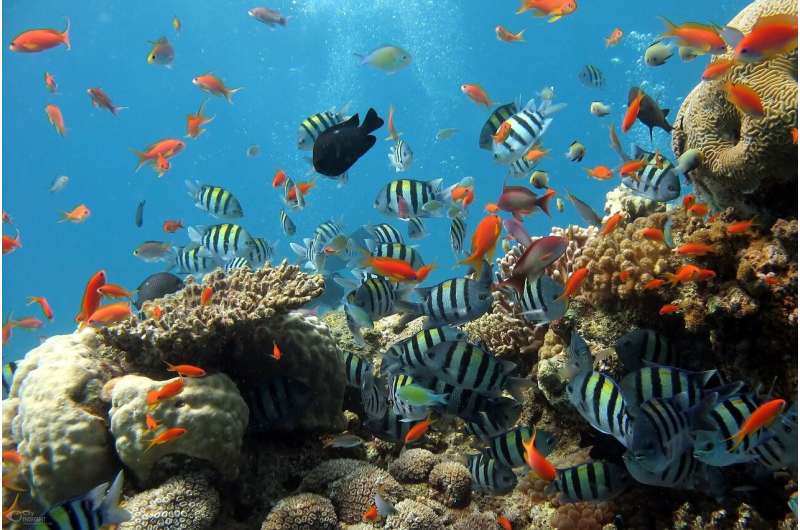Study identifies where coral reefs may be buffered against warming oceans

As warming ocean temperatures threaten the existence of coral reefs, scientists at the National Center for Atmospheric Research (NCAR) have successfully used an extremely high-resolution computer simulation of ocean circulation to identify possible "thermal refugia" where these biodiverse ecosystems are more likely to survive.
The research team has published an interactive, freely available online global atlas with the locations of these areas, where ocean dynamics and cooler waters combine to provide possible havens for coral reefs.
"We hope this work serves as a starting point for other scientists who are interested in reefs," said NCAR scientist Scott Bachman, who led the new study, published in the journal Frontiers in Marine Science. "We invite researchers to look at our website, identify where refugia may be, and then go observe the health of the reefs."
The research was supported by the U.S. National Science Foundation, which is NCAR's sponsor. The study was co-authored by scientists at the University of Tasmania and the University of Auckland.
Waves of cooler water
Climate change poses such a threat to coral reefs worldwide that the majority are expected to be lost in less than three decades, with warming ocean waters bleaching the reefs and leaving behind lifeless skeletons. The loss of coral reefs has far-reaching ramifications for the environment and society. They are home to almost a third of marine species and support hundreds of millions of people worldwide. Reefs generate an estimated global economic value of $10 trillion per year, and the protection they provide to shorelines from storm and flood damage is worth billions of dollars each year, according to NCAR scientist and study co-author Joan Kleypas.
However, scientists have found that some reefs do fare better than others. In some regions of the ocean, for example, cooler water, lifted from the deep ocean by subsurface oscillations known as internal ocean gravity waves, can lap over the reefs and buffer them from increased heat.
"These gravity waves are everywhere, and under special conditions, they can bring cooler water near the surface of the ocean where reefs are," Bachman said. "You need powerful waves with large amplitudes to collide with physical obstacles, like a seamount, to force the waves to slosh upwards."
Scientists have understood for some time that this gravity wave phenomenon exists in select places. For example, a combination of the tides and the deep basins of the Coral Triangle—a marine area that includes the waters of Indonesia, Malaysia, the Philippines, and other nearby countries—create conditions that favor gravity waves bringing cooler water to the surface. But it has been difficult to determine all the places across the globe where similar conditions could exist, in part because the gravity waves may not bring the water all the way to the surface and therefore cannot be identified by satellites.
Without the ability to observe the thermal refugia from space, scientists are left with computer modeling as a tool to identify them globally. The main obstacle for models, however, is scale. Coral reefs are relatively tiny compared to the vastness of the ocean, and running a simulation at high enough resolution over the entire globe to capture how gravity waves interact with a specific reef requires massive computational resources.
However, one such simulation exists. NASA's Estimating the Circulation and Climate of the Ocean (ECCO) Project simulated the entire ocean at a resolution of about 2 kilometers and saved data at hourly time steps, frequent enough to accurately capture how internal gravity waves behave. To do the analysis that was necessary to identify thermal refugia, Bachman downloaded a staggering 400 terabytes of data from the ECCO Project.
"This type of study is not uncommon on a local scale," Bachman said. "But it's rare on a regional scale, and until now, it's never before been done on a global scale."
The resulting atlas offers some hope, according to Kleypas, who has conducted pioneering research into the effects of climate change on coral reefs.
"Coral reefs are not doing well, and we've all been going through a period of mourning," Kleypas said. "This study highlights where there is cause for hope. We're not saying that this atlas will solve everything, but it can help us be smarter about our approach to conserving the reefs that have the best chance of survival."
More information: Scott D. Bachman et al, A global atlas of potential thermal refugia for coral reefs generated by internal gravity waves, Frontiers in Marine Science (2022). DOI: 10.3389/fmars.2022.921879
Global Atlas: ncar.github.io/coral-viz/
Journal information: Frontiers in Marine Science
Provided by National Center for Atmospheric Research




















